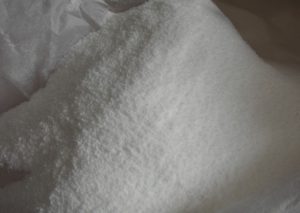EDTA MSDS
1. SUBSTANCE IDENTIFICATION
- 1.1. Product Name: EDTA
- 1.2. Description: EDTA is a aminopolycarboxylic acid manufactured through chemical synthesis.
- 1.3. Chemical Formula: C10H16N2O8
- 1.4. Molecular weight: 292.24
- 1.5. CAS #: 60-00-4
- 1.6. EINECS #: 200-449-4
- 1.7. Manufactured by: China manufacturer.
- 1.8. Supplied by:China EDTA manufacturer.
- 1.9. Usage: In food as stabilizer in cosmetic and personal care products
2. Composition
- 2.1. EDTA: >99.1%
- 2.2. Hazardous impurities: CHLORIDES (Cl) No more than 0.05%
3. Physical/Chemical Characteristics
- 3.1. Physical State: powder.
- 3.2. Appearance: Pure White Free Flowing Crystalline Powder
- 3.3. Odor: Odorless.
- 3.4. pH: 10.5-11.5
- 3.5. Melting point/range: Decomposition temperature: 220-240°C (464°F)
- 3.6. Boiling point: Not available
- 3.7. Bulk density: 0.86 g/cm3
- 3.8. Solubility: Very slightly soluble in cold water.
4. Stability/Reactivity
- 4.1. Chemical Stability: Stable under normal temperatures and pressures
- 4.2. Shelf Life: 6 months
- 4.3. Hazardous decomposition: Carbon oxides (CO, CO2), nitrogen oxides (NO, NO2…)
- 4.4. Hazardous polymerization: Will not occur
- 4.5. Incompatible with: Strong oxidizers.
5. Handling/Storage
- 5.1. Storage: Stored in a cool and dry place and Keep away from strong light and heat
- 5.2. Handling precaution: Keep locked up.. Keep away from heat. Keep away from sources of ignition. Empty containers pose a fire risk, evaporate the residue under a fume hood. Ground all equipment containing material.
6. Exposure Control
- 6.1. Engineering Controls: Use process enclosures, local exhaust ventilation, or other engineering controls to keep airborne levels below recommendedexposure limits.
- 6.2. Respiratory protection: NIOSH/MSHA or European Standard EN 149 approved respirator
- 6.3. Eye Protection: Protective eyeglasses or chemical safety goggles
- 6.4. Skin Protection: Wear appropriate protective gloves and clothes to minimize skin contact.
- 6.5. Other: Consult professionals if EDTA need to be handled under some special conditions.
7. Hazards Identification
- 7.1. Hazardous overview: EDTA is Slightly hazardous in case of skin contact (irritant), of eye contact (irritant), of ingestion, of inhalation. Severe over-exposure can result in death.
- 7.2. Contact with eyes: May cause eye irritation.
- 7.3. Contact with skin: May cause skin irritation.
- 7.4. Ingestion: May cause irritation of the digestive tract.
- 7.5. Inhalation: May cause irritation to the respiratory tract and gastrointestinal
- 7.6. Other: Not Applicable
8. First Aid Measures
- 8.1. Contact with eyes: Flush with plenty of water or eye wash solution for 15 minutes. Cold water may be used. WARM water MUST be used. Get medical attention if irritation persists.
- 8.2. Contact with skin: Wash with soap and water. Cover the irritated skin with an emollient. Get medical attention if irritation develops
- 8.3. Ingestion: Do NOT induce vomiting. If victim is conscious and alert, give 2-4 cupfuls of milk or water. Never give anything by mouth to an unconscious person. Get medical aid immediately.
- 8.4. Inhalation: Remove to fresh air. If not breathing, give artificial respiration. If breathing is difficult, give oxygen. Get medical attention.
9. Fire and Explosion Data
- 9.1. General information: May be combustible at high temperature.
- 9.2. Flash point: Not available
- 9.3. Ignition control: Avoid Daidzein ignition sources EDTA dust might be generated.
- 9.4. Dust control: Keep the handling area with adequate ventilation
- 9.5. Extinguishing Media: Not available
- 9.6. Spills/Leaks: Use appropriate tools to put the spilled solid in a convenient waste disposal container. Finish cleaning by spreading water on the contaminated surface and dispose of according to local and regional authority requirements.
10. Transport Information
- 10.1. No special requirements and no restrictions on transportation by land, sea or air.
11. Ecological Information
- 11.1. EDTA is fully degradation biodegradable.
12. Other Information
- 12.1. The information in EDTA MSDS was obtained from current and reliable sources. However, the data is provided without any warranty, expressed or implied, regarding its correctness or accuracy. Since the conditions for use, handling, storage and disposal of this product are beyond our control, it is the responsibility of the user both to determine safe conditions for use of this product and to assume liability for loss, damage, or expense arising out of the products improper use. No warranty expressed or implied regarding the product described herein will be created by or inferred from any statement or omission in the MSDS. Various federal, state, or provincial agencies may have specific regulations concerning the transportation, handling, storage, use, or disposal of this product which may not be reflected in the MSDS. The user should review these regulations to ensure full compliance.

